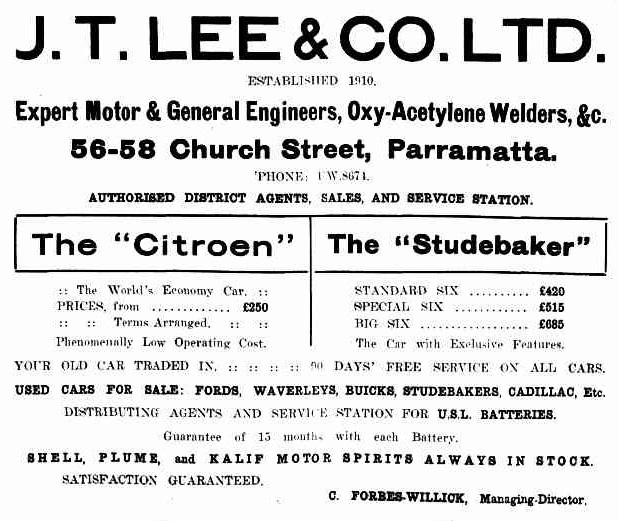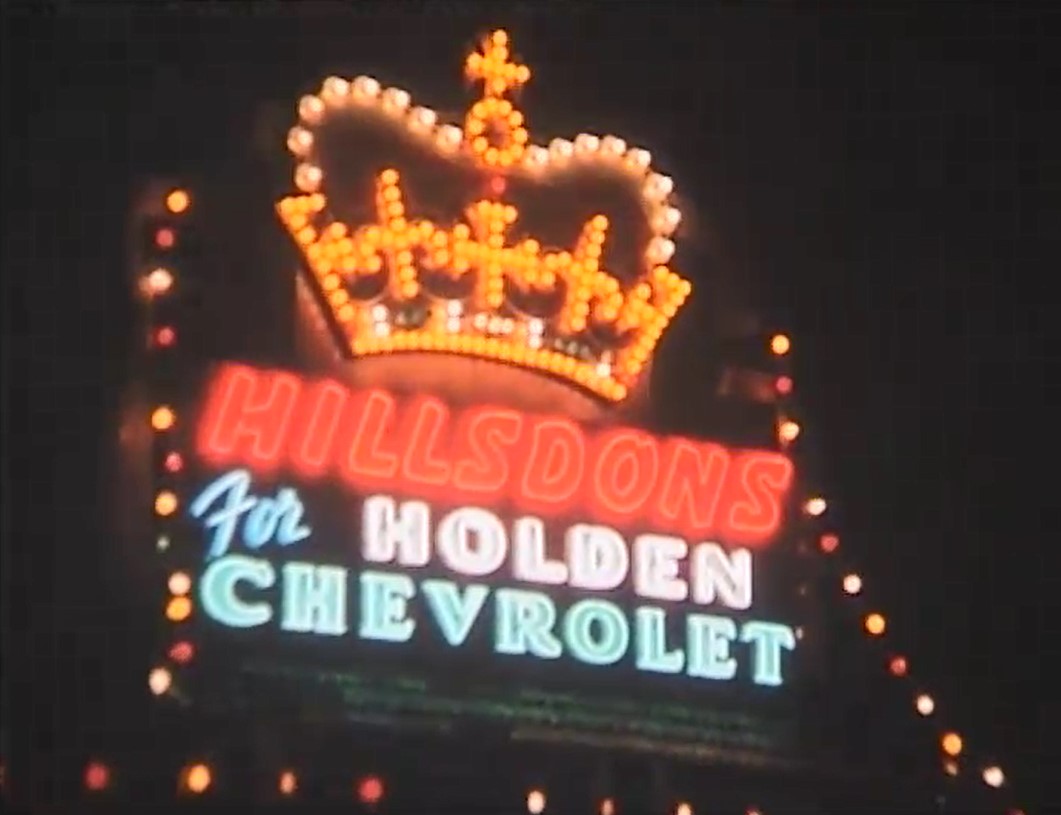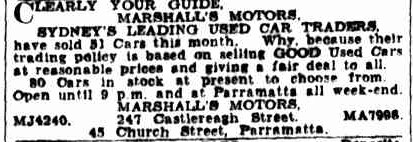
“Come on out to Parramatta, and walk down Auto-alley”… so went the jaunty jingle aimed at enticing Sydney-siders to make the journey out west to Parramatta when considering the purchase of their new or used car [1]. Gradually, as more businesses were established or relocated from Sydney to Parramatta the so called ‘auto-alley’ was firmly established by the early 1970s as ‘the’ place to purchase a new or used vehicle. This area will soon be transformed as car yards make way for mixed use neighbourhoods including residential and retail precincts.
The concentration of car sales yards at the Western end of Parramatta Road leading into Church Street, Parramatta had its origins in the early years of the 20th century. At this time motor vehicle ownership was restricted to wealthy citizens and as the price of vehicles decreased more of the population could afford this new mode of travel. Motorised and horse-drawn vehicles still shared the streets up until the 1940s.

(Source: Cumberland Argus. 27 March 1925 p 11)
Estimates of the number of vehicles in Australia were published in the Commonwealth Year Book No. 16 for 1923. In 1921 there were almost 100,000 motor vehicles and over 37,000 motor cycles in Australia. This represented approximately one vehicle per 45 persons. By 1930, this had risen to one vehicle per 11 persons. The size of the fleet increased steadily until 1939 and then declined over the years of the Second World War (1940-1945) [2].
As the popularity of motor vehicles grew, enterprising business owners saw the opportunities presented by his new form of transport, including Lee Bros, a company that was founded during the horse and cart era. New businesses such as Hillsdon’s and Hunt Bros. were some of the first sales yards to be located in this area. The firm known as S. J. Hillsdon Cycleworks initially retailed bicycles but by the late 1920s, Walter Hillsdon [3] had greatly expanded the business and the company was an agent for Chevrolet cars and trucks.

(Source: City of Parramatta Council Archives Film Footage Collection, PRS77/003)
In 1938, Hillsdon’s celebrated 31 years in the Parramatta District with the opening of its modern service station with electric fuel pumps and tube lighting on the corner of Church Street and the Great Western Road [4]. Further along Church Street, C. G. Sowell was an agent for the British made Douglas motor cycles and bicycles. Retailers of parts and accessories could also be found along this section of Church Street. Advanx advertised “get your tyres from us at city prices” while the H & B Service Station featured batteries for “car or wireless” and offered a “one day battery charging service” [5].
Parramatta’s first NRMA Depot was located on the premises of Lee Bros at 60 Church Street. This motor and general engineering firm was founded on Argus Lane, Parramatta before moving to Church Street in 1910 where it continued to operate until August 1988. As motor vehicles replaced horse-drawn transport, Lee Bros expanded their range of services. During World War Two Lee Bros also serviced tanks for the Australian Army [6].
By the late 1930s, second-hand car dealers such as Marshall’s Motors had established branches in Church Street, Parramatta [7].

(Source: Sydney Morning Herald.24 March 1939, p.3)
The hiatus in vehicle ownership due to the war had passed by the 1950s, and by 1955 there were two cars for every five people in Australia [8].
Through the second half of the 20th century, Church Street continued to be a renowned location for car sales, although other areas such as North Parramatta and the Great Western Highway also began gaining in popularity amongst business owners. Retailers in Church Street banded together and commenced marketing campaigns promoting the ‘Auto-alley’ area as ‘the’ place to go to find your next vehicle.
In 1984, the appearance of the area was greatly improved by the removal of overhead power lines along Church Street between the Vauxhall Inn and Great Western Highway, and the installation of new street lighting. Church Street the first major traffic route in Sydney to receive this treatment [9].
In 2006, the then Lord Mayor, David Borger suggested that this renowned strip of Church Street be turned into a model high-rise, mixed use neighbourhood [10].
As the era of large scale car sales yards in Parramatta began drawing to an end, planning for the redevelopment of ‘Auto-alley’ commenced. In 2014, the Parramatta Advertiser reported that three sites had been selected for a $800 million mixed-use development consisting of residential towers, retail or commercial uses, public open spaces, parkland, car parking and social spaces. The development would also provide opportunities for cafes and outdoor dining, a pedestrian plaza and bus and cycle lanes [11]. A report prepared by SGS Economics and Planning for the Sydney Metropolitan Development Authority (2010) stated that “the preferred strategy for urban renewal in the Auto Alley precinct is a medium to high density mixed use living and working urban environment” [12].
In August 2017, the Parramatta Advertiser reported “the end of the road for Auto-alley”. Long term employees lamented the end of the era for the strip that had been a significant landmark in the area for many decades. Dubbed the southern gateway to the city of Parramatta, the development of the new mixed-use precinct will create “a vibrant place for people to enjoy” [13].

(Image: www.buildsydney.com)
![]()
Cathy McHardy, Research Assistant, Parramatta Heritage and Visitor Information Centre, 2021
References:
[1] Television advertisement for ‘Auto-alley’ (1989)[Video file] Retrieved on 07/02/2019 from https://www.youtube.com/watch?v=aiGKuB2LIW0
[2] Australian Bureau of Statistics. (2001). Australia’s motor vehicle fleet since the 1920s. Retrieved on 12/02/2019 from
http://www.abs.gov.au/ausstats/abs@.nsf/0/39F42D529B84BEA2CA2569DE0028B410?Opn
[3] Enterprising motor dealer. Mr. Walter Hillsdon: Elaborate business premises. (20 January 1928). Cumberland Argus, p. 17. Retrieved 07/02/2019 from https://trove.nla.gov.au/newspaper/article/107092023
[4] Advertisement: Hillsdons Pty. Ltd. (26 October 1938). Cumberland Argus. P. 27. Retrieved on 12/02/2019 from https://trove.nla.gov.au/newspaper/article/104974716
[5] Advertisement: C. G. Sowell, and Advanx. (20 January 1928). Cumberland Argus, p. 17. Retrieved on 12/02/2019 from https://trove.nla.gov.au/newspaper/article/107092018
[6] Century later, doors to shut. (24 August 1988). Parramatta Advertiser. p. 14.
[7] Advertisement: Marshall’s Motors. (24 March 1939). The Sydney Morning Herald. P. 3. Retrieved on 07/02/2019 from https://trove.nla.gov.au/newspaper/article/17575954/1173104
[8] Kass et al (1996). Parramatta: A Past Revealed, Sydney: Parramatta City Council, p. 379.
[9] Main drag loses poles and wires. (29 August 1984). Parramatta Advertiser. p. 2.
[10] Cr has plans for caryards. (20 Sept 2006). Parramatta Advertiser. p. 5.
[11] Church St revamp moves ahead. (30 April 2014). Parramatta Advertiser. p. 3.
[12] Sydney Metropolitan Development Authority. Urban Renewal Plan for Auto Alley at Parramatta. n.d. Retrieved 07/02/2019 from https://www.sgsep.com.au/projects/urban-renewal-plan-auto-alley-parramatta
[13] End of the road for auto-alley, highrise development set to replace car yard hub: bulldozers to ‘change our way of life’: dealer. (30 August 2017). Parramatta Advertiser. pps. 1, 8-9. Retrieved 07/02/2019 from https://www.smh.com.au/business/companies/parramatta-auto-alley-gets-new-life-as-225m-mixed-precinct-20170830-gy74y9.html 30 Aug 2017
- Log in to post comments


